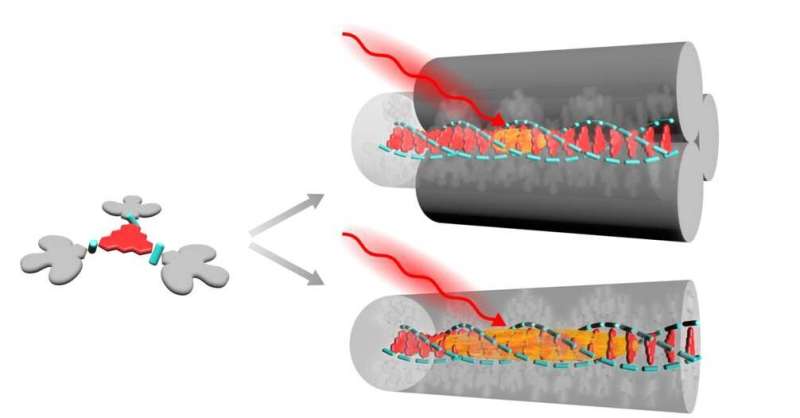Transporting energy through a single molecular nanowire

Photosynthetic systems in nature transport energy very efficiently toward a reaction center, where it is converted into a useful form for the plant. Scientists have been using this as inspiration to learn how to transport energy efficiently in molecular electronics and other technologies. Physicist Richard Hildner from the University of Groningen and his colleagues have investigated energy transport in an artificial system made from nanofibers. The results were published in the Journal of the American Chemical Society.
"Natural photosynthetic systems have been optimized by billions of years of evolution. We have found this very difficult to copy in artificial systems," explains Hildner, associate professor at the University of Groningen. In the light-harvesting complexes of bacteria or plants, light is converted into energy, which is then transported to the reaction center with minimal losses.
Bundles
Five years ago, Hildner and his colleagues developed a system in which disc-shaped molecules were stacked into nanofibers with lengths exceeding 4 micrometers and a diameter of just 0.005 micrometers. By comparison, the diameter of a human hair is 50 to 100 micrometers. This system can transport energy like the antennas in photosynthetic systems. "But we sometimes saw that energy transport became stuck in the middle of our four micrometer-long fibers. Something in the system appeared to be unstable," he recalls.
To improve the energy transport efficiency, Hildner and his colleagues created bundles of nanofibers. "This is the same idea as that which is used in normal electronics: very thin copper wires are bundled together to create a more robust cable." However, the bundled nanofibers turned out to be worse at transporting energy than single fibers.
Coherence
The reason is a phenomenon called coherence. When energy is put into the molecules that make up the fibers, it creates an excited state or exciton. However, this excited state is not a packet of energy that is associated with a single molecule. Hildner: "The energy is delocalized over several molecules and it can, therefore, move fast and efficiently across the fiber." This delocalization means that the energy moves like a wave from one molecule to the next. By contrast, without coherence, the energy is limited to a single molecule and must hop from one molecule to the next. Such hopping is a much slower way to transport energy.
"In the bundles, coherence is lost," explains Hildner. This is caused by the strain that the bundle imposes on each fiber within it. "The fibers are compressed, and this causes side groups of the molecules to crash into each other." This changes the energy landscape. In a single fiber, the energy of the excited states of several neighboring molecules are at the same level. In a bundle, the local environments of the molecules differ, leading to a difference in energy levels.
Bike tour
"Imagine that you are on a bike tour. The height profile of the tour represents the energy levels in the molecules that make up the fibers," says Hildner. "If you are cycling in the Netherlands, you will arrive at your destination quickly because the terrain is flat. In contrast, in the Alps, you must cycle uphill quite often, which is tough and slows you down." Thus, when the molecules' energy levels in the fibers are different, transport becomes more difficult.
This discovery means that the team's original idea—to increase energy transport efficiency using bundles of nanofibers— turned out to be a failure. However, they have learned valuable lessons from this, which can now be used by theoretical physicists to calculate how to optimize transport in molecular fibers. "My colleagues at the University of Groningen are currently doing just that. But we already know one thing: If you want good energy transport in nanofibers, do not use bundles."
Simple Science Summary
Plants and photosynthetic bacteria catch sunlight via molecular antennas, which then transfer the energy to a reaction centre with minimal losses. Scientists would like to make molecular wires that can transfer energy just as efficiently. Scientists at the University of Groningen created tiny fibers by stacking certain molecules together. Single fibers transport energy, although they sometimes malfunction. Creating bundles of fibers (as is done with copper wiring) was thought to be the solution but this turned out not to be the case. Energy moves fast when spread out across several molecules. In single fibers, this works well but in bundled fibers, this spreading out is hampered as the molecules experience strain. These results can be used to better understand energy transport along molecular wires, which will help in the design of better wires.
More information: Bernd Wittmann et al, Enhancing Long-Range Energy Transport in Supramolecular Architectures by Tailoring Coherence Properties, Journal of the American Chemical Society (2020). DOI: 10.1021/jacs.0c01392
Journal information: Journal of the American Chemical Society
Provided by University of Groningen





















